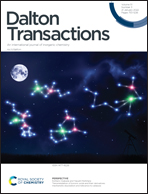Ligand isomerism fine-tunes structure and stability in zinc complexes of fused pyrazolopyridines†
Abstract
Fused-ring pyrazoles offer a versatile platform for derivitization to give finely tuned and functional ligands in coordination assemblies. Here, we explore the pyrazolo[4,3-b]pyridine (HL1) and pyrazolo[3,4-c]pyridine (HL2) backbones and their N-substituted derivatives, using their coordination chemistry with zinc(II) in the solid state and in solution to examine the steric and electronic effects of varying their substitution pattern. The parent heterocycles HL1 and HL2 both generate robust and permanently porous isomeric MOFs on reaction with zinc and a dicarboxylate co-ligand. The subtle geometric change offered by the position of the backbone pyridyl nitrogen atom leads to substantial changes in the pore size and total pore volume, which is reflected in both their surface areas and CO2 uptake performance. Both materials are also unusually resilient to atmospheric water vapour by virtue of the strong metal–azolate bonding. The isomeric chelating ligands L3–L6, generated by N-arylation of the parent heterocycles with a 2-pyridyl group, each coordinate to zinc to give either mononuclear or polymeric coordination compounds depending on the involvement of the backbone pyridine nitrogen atom. While crystal packing influences based on the steric preferences of the ligands are dominant in the crystalline phase, fluorescence spectroscopy is used to show that the 2H isomers L4 and L6 show distinct coordination behaviour to the 1H isomers L3 and L5, forming competing [ML] and [ML2] species in soution. The first stability constant for L6 with zinc(II) is an order of magnitude larger than for the other three ligands, suggesting an improved binding strength based on the electron configuration in this isomer. These results show that careful control of remote substitution on fused pyrazole ligands can lead to substantial improvements in the stability of the resulting complexes, with consequences for the design of stable coordination assemblies containining labile metal ions.



 Please wait while we load your content...
Please wait while we load your content...